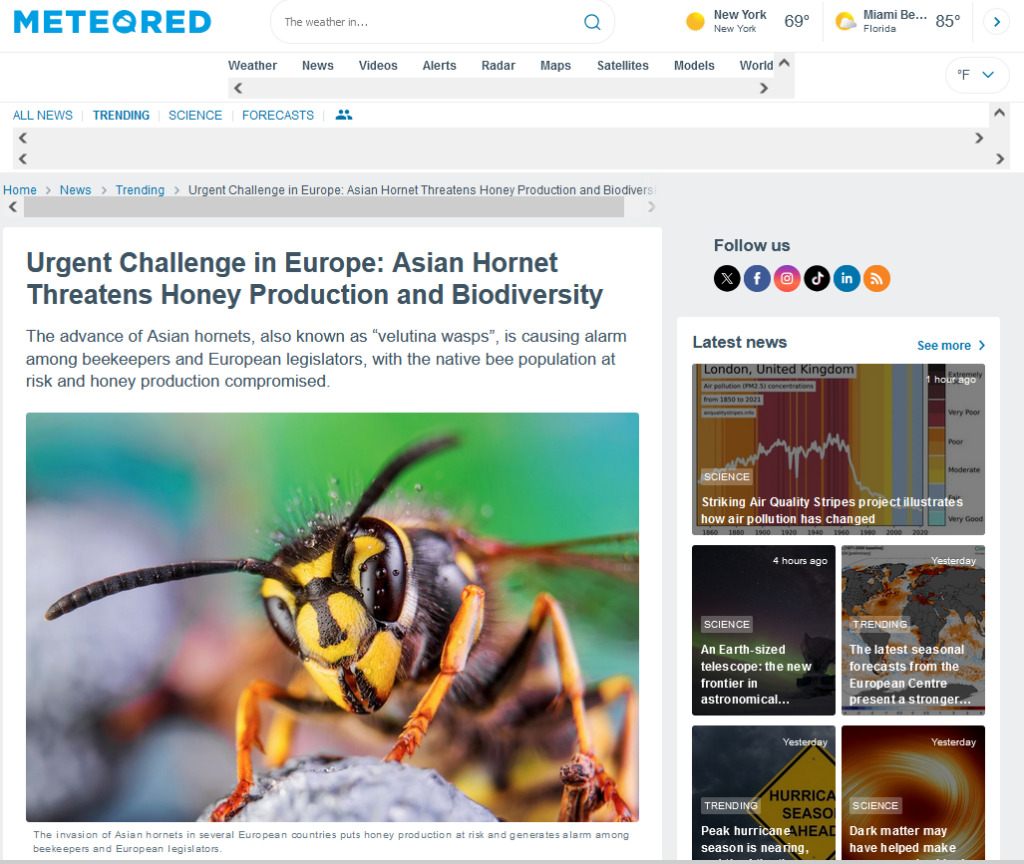HornetSentry
The first comprehensive non-lethal protection for bees and hives against hornets
The Invasive Hornet Problem
In Europe, beekeeping faces two threats from hornets. European hornets (Vespa crabro) pose a danger to bees but not to the entire hive. They are not as aggressive and typically prey on individual bees near the hive. In contrast, the Asian hornet (Vespa velutina), an invasive species, presents a much greater risk. It arrived in Europe in 2004 through France and has been spreading at a rate of 60-100 km per year. Today, it is found not only in France but also in Spain, Belgium, Italy, Portugal, and the United Kingdom. This predator can not only hunt bees but also invade hives, kill worker bees, and consume larvae, effectively destroying the entire colony.
Read More





Attacks by Asian hornets have already caused significant losses in bee colonies and honey production in Europe, including a 30-50% decline in areas like Liguria, Italy. This poses a serious threat not only to beekeeping but also to overall biodiversity and pollination.
The threat posed by the spread of the invasive hornet is far beyond manageable. To date, tens of thousands of nests have been found and destroyed across Europe.
Source of background image: animalia.bio
Current solutions
Beekeepers in both Asia and Europe use several methods to protect their hives from hornet attacks:
Sticky traps
A sticky board is set near the hive. The hornet gets stuck on it and later dies from hunger and exhaustion. In the meantime, it releases pheromones to call for help, attracting more hornets that also get trapped.
Trap containers
The hornet is attracted by a mixture of pheromones and a sweet bait. Once inside the container, it is unable to find its way out and most often dies by drowning.
Manual extermination
For some beekeepers, hornets pose such a significant problem that they are willing to personally stand guard over their hives and manually exterminate the hornets.
In our view, these methods have significant drawbacks. The traps are not selective and often kill other beneficial insects, including bees from the very hive they are meant to protect. Manual extermination is time-consuming and, due to the aggressiveness of hunting hornets, dangerous for humans. Additionally, this approach does not seem suitable for larger apiaries or areas with a high density of hornet populations.
Access control

The only solution that avoids killing hornets is restricting access to the hive with a metal slit or mesh. While this prevents hornets from entering the hive, it does not stop them from hunting bees in front of it.
Our Philosophy
Although hornets are often perceived as pests, they play an irreplaceable role in the ecosystem. Our approach is based on the belief that protecting bee colonies does not have to involve killing hornets. We recognize that humans have created an imbalance by placing large numbers of hives in one area, providing hornets with an easily accessible food source. However, eliminating hornets that hunt bees in these areas would only create further imbalance. Therefore, HornetSentry merely repels hornets without further disrupting the natural balance.
The goal of the HornetSentry project is to develop a solution that reduces the time and financial burden for beekeepers in an environmentally sustainable way.
We believe that technological innovation combined with an ecological approach is a synergy essential for the future development of agriculture. Our device not only protects bees but also contributes to the development of similar technologies for application in other areas.
Source of background image: Quang Nguyen Vinh
HornetSentry
Within the HornetSentry project, we are developing a device that automatically and efficiently protects bees and beehives from hornet attacks without killing the hornets. It operates on the principle of detecting hornets using advanced image and sound recognition technologies. Once a hornet is identified near the hive, it is promptly and selectively deterred from hunting bees or attempting to enter the hive.
How it works
1.
Monitoring
The device monitors the area in front of the hives using a combination of cameras and microphones
2.
Identification
The program identifies any hornets in the area in front of the hive
3.
Deterrence
The hornet is selectively repelled without affecting the bees in the monitored area
Why HornetSentry?
- Safe
- Autonomous
- Silent
- Robust
- Non-chemical
- Self-powered
- Operates 24 hours a day
- Protects bees inside the hive
- Protects bees outside the hive
- Doesn't kill hornets
- Harmless to bees
Cooperation
We are currently cooperating with the Faculty of Mechanical Engineering and the Faculty of Electrical Engineering and Communication at Brno University of Technology.
We are also in discussions about collaboration with several other universities from around the world.
Contact
Are you interested in our project?
Are you part of an institution or company and interested in establishing a collaboration?
Are you an individual who would like to join our team?
Do you have a question about the HornetSentry project?
Contact us
